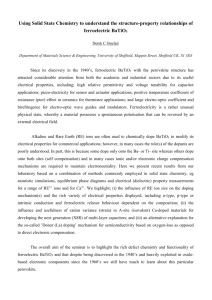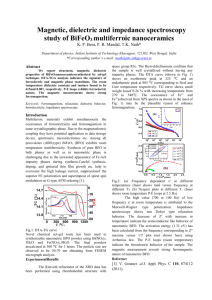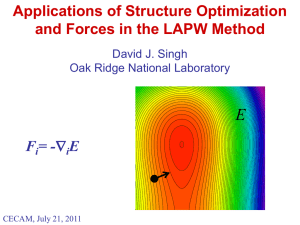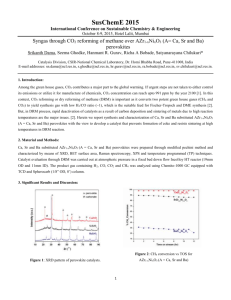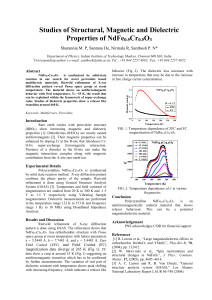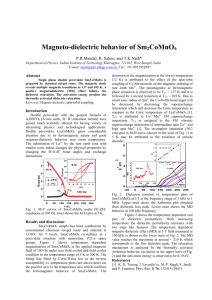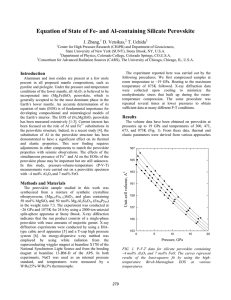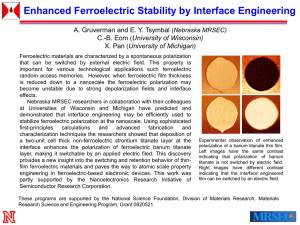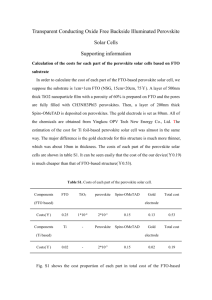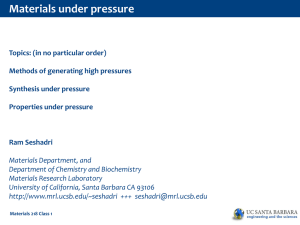Perovskites: crystal structure, important compounds and properties
advertisement
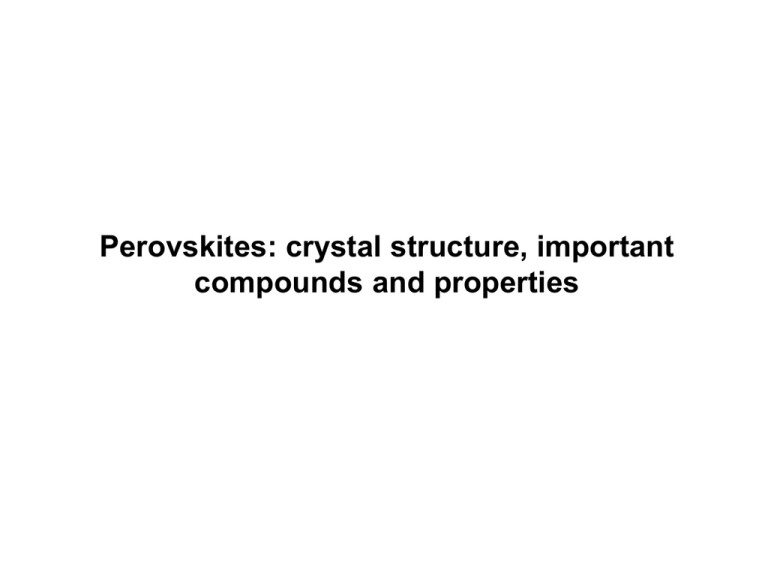
Perovskites: crystal structure, important compounds and properties Very stable structure, large number of compounds, variety of properties, many practical applications. Key role of the BO6 octahedra in ferromagnetism and ferroelectricity. Extensive formation of solid solutions material optimization by composition control and phase transition engineering. A2+ B4+ O2- Ideal cubic perovskite structure (ABO3) Pm 3 m Oxygen Octaedra Octaedral site B cations : Nb, Ta, Ti, Zr, Fe, Mn, …. Dodecaedral site A cations : K, Na, Ca, Sr, Ba, Pb, Bi, Y, La, … Cubic perovskite SrTiO3 3 Goldschmidt’s tolerance factor t rA rO 2 rB rO The perovskite structure is stable when 0.89 t 1.06 (taking rO = 0.14 nm). Ideal cubic structure only observed at room temperature when t is close to 1. If A ions are small, t <1, and tetragonal, orthorhombic and rhombohedral deformations of structure due to rotation and tilting of the BO6 octahedra are observed. Other types of deformations are induced by the appearance of spontaneous polarization in ferroelectric perovskites. Because of its flexibility, the perovskite structure can accommodate ions with different size and charge (AIBVO3, AIIBIVO3, AIIIBIIIO3) and the same site can be shared by ions with different charge (Ba(Mg1/3Nb2/3)O3 , Pb(Mn1/3Nb2/3)O3). The perovskite structure provides the building blocks for the assembly of other important crystal structures: RoddlesdenPopper phases (Can+1TinO3n+1), Aurivillius compounds 2+ 2((Bi2O2) (Bim-1TimO3m+1) ) and oxygen-deficient brownmillerite compounds (CaAlFeO5) Ideal cubic perovskite structure (SrTiO3) A2+ B4+ O2- Distorted perovskite structure (CaTiO3) BO6 A Orthorhombic perovskite ABO3 Reference compound Properties Existing and potential applications Notes BaTiO3 Ferroelectricity, piezoelectricity, high dielectric constant Multilayer ceramic capacitors (MLCCs), PTCR resistors, embedded capacitance Most widely used dielectric ceramic TC = 125°C (Ba,Sr)TiO3 Non-linear dielectric properties Tunable microwave devices Used in the paraelectric state Pb(Zr,Ti)O3 Ferroelectricity, piezoelectricity Piezoelectric transducers and actuators, ferroelectric memories (FERAMs) PZT: most successful piezoelectric material Bi4Ti3O12 Ferroelectric with high Curie temperature High-temperature actuators, FeRAMs Aurivillius compound TC = 675°C (K0.5Na0.5)NbO3, Na0.5Bi0.5TiO3 Ferroelectricity, piezoelectricity Lead-free piezoceramics Performances not yet comparable to PZT but rapid progress (Pb,La)(Ti,Zr)O3 Transparent ferroelectric Optoelectronic devices First transparent ferroelectric ceramic BiFeO3 Magnetoelectric coupling, high Curie temperature Magnetic field detectors, memories Most investigated multiferroic compound. TC = 850°C PbMg1/3Nb2/3O3 Relaxor ferroelectric Capacitors, actuators High permittivity, large electrostrictive coefficients, frequency-dependent properties SrRuO3 Ferromagnetism Electrode material for epitaxial ferroelectric thin films (La, A)MnO3 A = Ca, Sr, Ba Ferromagnetism, giant magnetoresistance, spinpolarized electrons Magnetic field sensors, spin electronic devices SrTiO3 Incipient ferroelectricity, thermoelectric power, metallic electronic conduction when n-doped, mixed conduction when p-doped, photocatalyst Alternative gate dielectric material, barrier layer capacitors, substrate for epitaxial growth, photoassisted water splitting Multifunctional material LaGaO3 BaIn2O5 Oxyde-ion conduction Electrolyte in solid oxide fuel cells (SOFCs) BaIn2O5 is an oxygen deficient perovskite with brownmillerite structure. BaCeO3, BaZrO3 Proton conduction Electrolyte in protonic solid oxide fuel cells (PSOFCs) High protonic conduction at 500-700°C (La,Sr)BO3 (B = Mn, Fe, Co) Mixed conduction, catalyst Cathode material in SOFCs, oxygen separation membranes, membrane reactors, controlled oxidation of hydrocarbons, Used for SOFC cathodes LaAlO3 YAlO3 Host materials for rare-earth luminescent ions, Lasers Substrates for epitaxial film deposition
